Immediate failure errors are recorded at any time they occur during the test regardless of whether or not the applicant was undertaking an assessable task at the time of the error. All driving actions resulting in immediate danger to any road user or to property are classified as immediate failure errors and would usually be when the applicant is operating the vehicle carelessly, dangerously or recklessly. Immediate failure errors are the most dangerous errors of all, and result in immediate failure of the test.
Immediate failure errors:
- Testing Officer (TO) intervention
- failure to carry out an instruction
- collision
- excessive speed
- failure to give way
- stopping at dangerous position
- failure to stop
- other dangerous action.
TO intervention
Explanation
The applicant must be able to demonstrate they can independently drive safely to the high standard required for the awarding of a full licence, ie without verbal or physical assistance.
Recorded if:
- The TO or support person in the vehicle provides any verbal or physical assistance to the applicant while the test is in progress.
- The TO or support person in the vehicle intervenes verbally or physically while the test is in progress to prevent a collision or prevent the development of an unsafe situation.
Exception
The applicant is not penalised if the TO repeats or clarifies an instruction while the assessment is in progress.
| Traffic movement |
Task |
 |
Figure 14 If an applicant commences a manoeuvre that will cause immediate danger, the TO should intervene.
Note: ‘P’ indicates a parked vehicle.
|
Failure to carry out instruction
Explanation
Failure to carry out instruction during the test indicates the applicant does not have the confidence or ability to correctly control the vehicle and does not meet the high standard required for the awarding of a full licence.
Recorded if:
- The applicant is unable, because of lack of driving ability, to carry out the TO’s instruction.
- The applicant disobeys a direction given by an enforcement officer.
Collision
Explanation
Causing the vehicle to collide with the kerb, an object or another road user during the test indicates the applicant does not have the ability to control the vehicle or negotiate the correct choice and does not meet the high standard required for the awarding of a full licence.
Recorded if:
- While entering or leaving a parking space or performing a three-point turn, one wheel mounts the kerb causing another road user to take evasive action or causing danger to property.
- While entering or leaving a parking space or performing a three-point turn, two or more wheels mount the kerb.
- Any wheel mounts the kerb at any time other than while entering or leaving a parking space or performing a three-point turn.
- The vehicle contacts the kerb other than while entering or leaving a parking space or performing a three-point turn.
- The vehicle touches any stationary object (such as a sign, fence, pole, tree or rubbish bin).
- The vehicle touches any other vehicle or road user (pedestrian or cyclist).
Exceptions
- The applicant is not penalised if their vehicle collides with another vehicle or road user and the collision is the fault of the other road user and the applicant did not contribute to the collision.
- An immediate failure error (collision) is not recorded if the applicant drives over part of the central island of a roundabout and that part of the central island is designed to be driven on by heavy vehicles. In this case, a critical error (other illegal action) is recorded.
| Traffic movement |
Task |
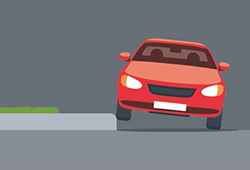 |
Figure 15 Immediate failure error (collision) – mounting the kerb of a roundabout or striking the kerb.
|
 |
Figure 16 Critical error (other illegal action) – driving on a part of the roundabout intended for use only by heavy vehicles.
|
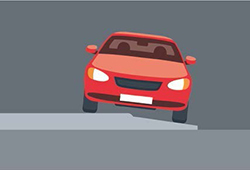 |
Figure 17 Immediate failure error (collision) – mounting or driving over a part of the roundabout not intended to be driven on by any vehicles.
|
Failure to give way
Explanation
Failing to give way during the test indicates the applicant does not have the ability to control the vehicle or negotiate the correct choice and does not meet the high standard required for the awarding of a full licence.
Recorded if:
- When merging or diverging (including lane changes), the applicant fails to signal, resulting in another road user taking evasive action.
- When merging or diverging (including lane changes), the applicant both fails to check relevant mirror(s) and fails to perform a head check, resulting in another road user taking evasive action.
- Another road user (to whom the applicant should have given way) is forced to take evasive action (or is otherwise unable to proceed) because of the applicant’s poor gap selection when:
- turning
- merging
- diverging (including lane changes)
- proceeding straight ahead at a Stop or Give Way sign
- entering a roundabout
- proceeding across a pedestrian crossing (failing to give way to a pedestrian
on the crossing).
| Traffic movement |
Task |
 |
Figure 18 Making a left turn into a gap in the traffic on a two-laned road.
|
Excessive speed
Explanation
Driving at excessive speed during the test indicates the applicant does not have the ability to control the vehicle or make the correct speed choice and does not meet the high standard required for the awarding of a full licence.
Recorded if:
- The applicant exceeds the speed limit by 5km/h or more for five seconds or more, or exceeds the speed limit by 10km/h or more for any duration.
Stopping at dangerous position
Explanation
When stopping, applicants must ensure they do so in a position that will not create a danger to themselves or other road users.
Drivers must not go into or attempt to cross an intersection, railway level crossing, pedestrian crossing or an area controlled by pedestrian traffic signals, if their intended passage or exit is blocked by stationary traffic.
Drivers must also not stop in a position that will obstruct the safe passage of other road users who have the right of way. Any necessary evasive action by a road user shows that the position of the vehicle potentially created a dangerous situation.
A pedestrian who diverges around a vehicle blocking a pedestrian crossing is at risk of being struck by other vehicles.
Recorded if:
- The applicant stops the vehicle at a position that intrudes onto or blocks a pedestrian crossing, causing a pedestrian to take evasive action (ie stop, slow,turn back, hurry or diverge around the vehicle).
- While waiting to turn right across oncoming traffic, the applicant stops the vehicle at a position that blocks a lane for oncoming traffic (other than a right-turn-only lane) (see Figure 19).
- While giving way at an intersection, the applicant unnecessarily stops the vehicle at a position that intrudes into the intersecting traffic stream (see Figure 20 and Figure 21).
- While waiting at an intersection or in a queue of traffic, the applicant stops in a cross-hatched clear zone marking indicated by cross-hatched yellow lines.
- The applicant stops the vehicle on a railway crossing.
- The applicant enters an intersection when their passage or exit is blocked by stationary traffic.
Exceptions
- When giving way at a Stop or Give Way sign or at a T-intersection, the presence of parked vehicles on the intersecting road may make it necessary to stop partly in the intersection to look for intersecting traffic (see Figure 22). The applicant is not penalised for stopping beyond the Stop or Give Way line, provided that:
- the applicant does not block a line of moving traffic travelling along the intersecting road but stops at a position protected by the line of parked vehicles
- the applicant does not block the path of a vehicle that is already waiting to turn right or is approaching the intersection and signalling the intention to turn right into the street the applicant is emerging from, and
- the applicant does not block the path of cyclists travelling along the intersecting road if such cyclists are present.
- It may be necessary to stop the vehicle on a pedestrian crossing to view approaching traffic before completing a turn at an intersection (see Figure 23). If the applicant takes all reasonable care to ensure that no pedestrian has to take evasive action, and it is necessary to stop on the pedestrian crossing to view approaching traffic, the applicant is not penalised. If more than one vehicle is queuing to make the turn, this exception applies only to the first vehicle in the queue (see Figure 24).
| Traffic movement |
Task |
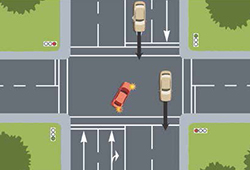 |
Figure 19 Stopping at a dangerous position while waiting to turn right, blocking a lane of oncoming traffic.
|
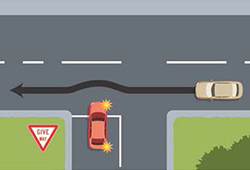 |
Figure 20 Stopping at a dangerous position that intrudes into a line of moving traffic.
|
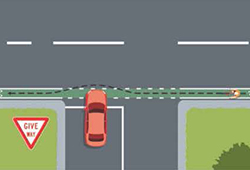 |
Figure 21 Stopping at a dangerous position that intrudes into the path of cyclists on the intersecting road.
|
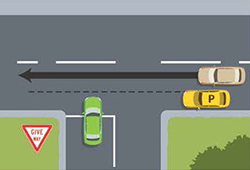 |
Figure 22 The driver is permitted to move forward to view approaching traffic, but must not obstruct a line of moving traffic.
Note: ‘P’ indicates a parked vehicle.
|
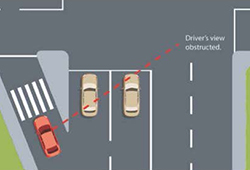 |
Figure 23 Stopping before the crossing may not provide an adequate view of traffic approaching from the right.
|
 |
Figure 24 The second queued vehicle should not encroach on the pedestrian crossing until the first vehicle has departed.
|
Failure to stop
Explanation
Drivers are required to stop at Stop signs and for red or yellow traffic lights.
Recorded if:
- The applicant drives through a Stop sign without stopping. This includes situations where the applicant slows and pauses, but fails to bring the vehicle to a complete stop (with the wheels motionless).
- The applicant fails to stop when required to do so at:
- a red or yellow traffic light
- a railway level crossing.
Other dangerous action
Explanation
Any other dangerous action (that results in immediate danger to road users or property) committed by the applicant during the test indicates they do not meet the high standard required for the awarding of a full licence.
Recorded if:
- The applicant performs a driving action not covered by the other immediate failure errors that:
- causes another road user to take evasive action
- causes immediate danger to road users or property
- will cause immediate danger to road users or property if the TO does not intervene
- unnecessarily increases the risk of a collision, eg maintains a following distance of less than one second from the driver in front.
Critical error
If the applicant performs an illegal driving action (other than those specified under the other immediate failure errors) that does not result in another road user taking evasive action or danger to road users or property, the appropriate critical error is recorded.
| Traffic movement |
Task |
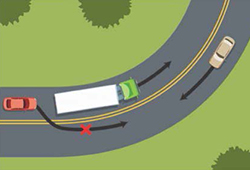 |
Figure 25 Illegal overtaking across double yellow lines while approaching a blind curve or crest of a hill.
|
 |
Figure 26 Driving on the wrong side of the road when approaching an intersection unnecessarily increases the risk of collision with a vehicle that may be approaching from the right, so an immediate failure error (other dangerous action) is recorded.
|












